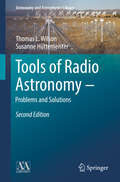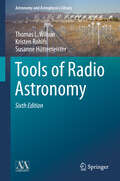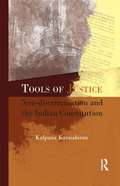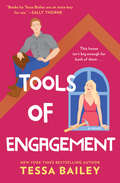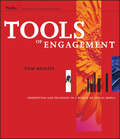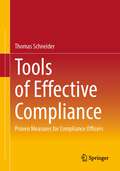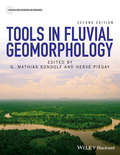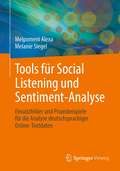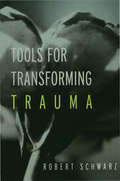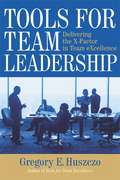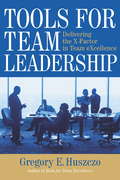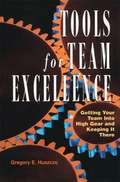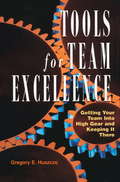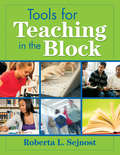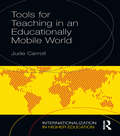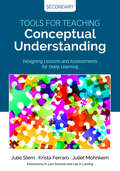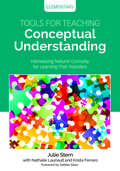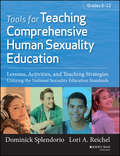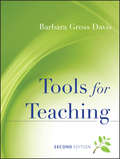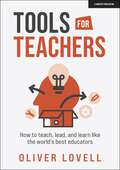- Table View
- List View
Tools of Radio Astronomy - Problems and Solutions (Astronomy and Astrophysics Library)
by Susanne Hüttemeister T. L. WilsonCovering topics of radio astronomy, this book contains graduate-level problems with carefully presented solutions. The problems are arranged following the content of the book "Tools of Radio Astronomy" by Rohlfs and Wilson (also available in this series) on a chapter-by-chapter basis. Some of these problems have been formulated to provide an extension to the material presented in "Tools of Radio Astronomy".
Tools of Radio Astronomy
by Thomas L. Wilson Kristen Rohlfs Susanne HüttemeisterThis 6th edition of "Tools of Radio Astronomy", the most used introductory text in radio astronomy, has been revised to reflect the current state of this important branch of astronomy. This includes the use of satellites, low radio frequencies, the millimeter/sub-mm universe, the Cosmic Microwave Background and the increased importance of mm/sub-mm dust emission. Several derivations and presentations of technical aspects of radio astronomy and receivers, such as receiver noise, the Hertz dipole and beam forming have been updated, expanded, re-worked or complemented by alternative derivations. These reflect advances in technology. The wider bandwidths of the Jansky-VLA and long wave arrays such as LOFAR and mm/sub-mm arrays such as ALMA required an expansion of the discussion of interferometers and aperture synthesis. Developments in data reduction algorithms have been included. As a result of the large amount of data collected in the past 20 years, the discussion of solar system radio astronomy, dust emission, and radio supernovae has been revisited. The chapters on spectral line emission have been updated to cover measurements of the neutral hydrogen radiation from the early universe as well as measurements with new facilities. Similarly the discussion of molecules in interstellar space has been expanded to include the molecular and dust emission from protostars and very cold regions. Several worked examples have been added in the areas of fundamental physics, such as pulsars. Both students and practicing astronomers will appreciate this new up-to-date edition of Tools of Radio Astronomy.
Tools of Justice: Non-discrimination and the Indian Constitution
by Kalpana KannabiranIn the years since independence, the Indian subcontinent has witnessed an alarming rise in violence against marginalized communities, with an increasing number of groups pushed to the margins of the democratic order. Against this background of violence, injustice and the abuse of rights, this book explores the critical, ‘insurgent’ possibilities of constitutionalism as a means of revitalising the concepts of non-discrimination and liberty, and of reimagining democratic citizenship. The book argues that the breaking down of discrimination in constitutional interpretation and the narrowing of the field of liberty in law deepen discriminatory ideologies and practices. Instead, it offers an intersectional approach to jurisprudence as a means of enabling the law to address the problem of discrimination along multiple, intersecting axes. The argument is developed in the context of the various grounds of discrimination mentioned in the constitution — caste, tribe, religious minorities, women, sexual minorities, and disability. The study draws on a rich body of materials, including official reports, case law and historical records, and uses insights from social theory, anthropology, literary and historical studies and constitutional jurisprudence to offer a new reading of non-discrimination. This book will be useful to those interested in law, sociology, gender studies, politics, constitutionalism, disability studies, human rights, social exclusion, etc.
Tools of Engagement: A Novel (Hot And Hammered Series #3)
by Tessa BaileyIn Tessa Bailey’s latest rom-com, two enemies team up to flip a house... and the sparks between them might burn the place down or ignite a passion that neither can ignore! Hair, makeup, clothing, decor... everything in Bethany Castle's world is organized, planned, and styled to perfection. Which is why the homes she designs for her family's real estate business are the most coveted in town. The only thing not perfect? Her track record with men. She's on a dating hiatus and after helping her friends achieve their dreams, Bethany finally has time to focus on her own: flip a house, from framework to furnishings, all by herself. Except her older brother runs the company and refuses to take her seriously. <P><P> When a television producer gets wind of the Castle sibling rivalry, they’re invited on Flip Off, a competition to see who can do the best renovation. Bethany wants bragging rights, but she needs a crew and the only member of her brother's construction team willing to jump ship is Wes Daniels, the new guy in town. His Texas drawl and handsome face got under Bethany's skin on day one, but the last thing she needs is some cocky young cowboy in her way. <P><P> As the race to renovate heats up, Wes and Bethany are forced into close quarters, trading barbs and biting banter as they remodel the ugliest house on the block. It's a labor of love, hate, and everything in between, and soon sparks are flying. But Bethany's perfectly structured life is one kiss away from going up in smoke and she knows falling for a guy like Wes would be a flipping disaster.
Tools of Engagement
by Tom BunzelTrainers, consultants, HR professionals need a resource for helping them apply social media technology to their meetings and training sessions. This resource shows how to get an online meeting scheduled, plan its contents, rehearse, and prepare, deliver meaningful content over the web, and follow up with a strategic plan to take full advantage of all aspects of the event going forward. It also covers continuing the dialog with other online technologies and shows how mashing and social networking can help train and teach. The book also includes Premium Content.
Tools of Effective Compliance: Proven Measures for Compliance Officers
by Thomas SchneiderUnlike many standard works on compliance, this book focuses not on the goals, but on the means that enable effective compliance. From the internal perspective of the compliance officer, everyday problems are addressed and solved with the help of concrete, tried-and-tested measures. Based on the tension between profit generation and compliance, ethical principles as well as the appearance of compliance, its handling of contacts and its procedure in the event of violations are also discussed. Psychological and sociological insights broaden the perspective, put people at the center and offer new starting points for the design of successful compliance.
Tools of Cooperation
by Clayton M. Christensen Howard H. Stevenson Jeremy B. DannIndustry and Background Note
Tools in Fluvial Geomorphology
by Hervé Piégay G. Mathias KondolfFluvial Geomorphology studies the biophysical processes acting in rivers, and the sediment patterns and landforms resulting from them. It is a discipline of synthesis, with roots in geology, geography, and river engineering, and with strong interactions with allied fields such as ecology and landscape architecture. This book comprehensively reviews tools used in fluvial geomorphology, at a level suitable to guide the selection of research methods for a given question. Presenting an integrated approach to the interdisciplinary nature of the subject, it provides guidance for researchers and professionals on the tools available to answer questions on river restoration and management. Thoroughly updated since the first edition in 2003 by experts in their subfields, the book presents state-of-the-art tools that have revolutionized fluvial geomorphology in recent decades, such as e.g., physical and numerical modelling, remote sensing and GIS, new field techniques and advances in dating, tracking and sourcing, statistical approaches as well as more traditional methods such as system concept, stratigraphic analysis, form and flow characterisation or historical analysis. This book: Covers five main types of geomorphological questions and their associated tools: historical framework; spatial framework; chemical, physical and biological methods; analysis of processes and forms; and future understanding framework. Provides guidance on advantages and limitations of different tools for different applications, data sources, equipment and supplies needed, and case studies illustrating their application in an integrated perspective. It is an essential resource for researchers and professional geomorphologists, hydrologists, geologists, engineers, planners, and ecologists concerned with river management, conservation and restoration. It is a useful supplementary textbook for upper level undergraduate and graduate courses in Geography, Geology, Environmental Science, Civil and Environmental Engineering, and interdisciplinary courses in river management and restoration.
Tools für Social Listening und Sentiment-Analyse: Einsatzfelder und Praxisbeispiele für die Analyse deutschsprachiger Online-Textdaten
by Melanie Siegel Melpomeni AlexaMit diesem Buch lernen Sie, wie Sie Social Listening und Sentiment-Analyse professionell einsetzen können. Der Leser erhält Schritt-für-Schritt-Beschreibungen für verschiedene Einsatzszenarien, gekoppelt mit Übungsaufgaben und nützlichen Materialien, darunter ein Merkblatt für Kennzahlen, eine Checkliste für die Toolauswahl und ein Glossar für Fachbegriffe. Dieses Lehr- und Praxisbuch verdeutlicht anhand von Anwendungsszenarien und Praxisbeispielen, wie Tools und Technologien für Social Listening und Sentiment-Analyse für die Analyse deutschsprachiger Online-Textdaten angewandt werden können und welche Vorteile diese bringen. Der Leser erhält einen Überblick über wichtige Funktionalitäten aktuell verfügbarer Social-Listening-Tools und deren Einsatzmöglichkeiten.
Tools for X-Teams: From Theory to Action--How to Build a Team that Will Maximize Your Company's Innovative Capacity
by Deborah Ancona Henrik BresmanSuppose you are a manager charged with creating a team. What, exactly, are the tools you need to craft a high-performing team? How can you facilitate a team's ability to engage in distributed leadership in action, pulling together the various resources inside and outside the organization, and up and down the organizational hierarchy, to bring the core mission and strategy of the company to life? This chapter describes the concrete steps you can take to construct an X-team, providing checklists that will help you along the way.
Tools for Transforming Trauma
by Robert SchwarzTools for Transforming Trauma provides clinicians with an integrative framework that covers a wide range of therapeutic modalities and a "black bag" full of therapeutic tools for healing trauma patients.
Tools for Team Leadership: Delivering the X-Factor in Team Excellence
by Gregory E. HuszczoThis self-study training guide puts the power of participative leadership into the hands of every manager, trainer, consultant, and team member struggling to help teams succeed. Packed with more than eighty new and field-tested tools, Tools for Team Leadership solves the mystery of why some teams-regardless of talent-succeed while others fail and delivers everything you need to master the "X-factor" skills of team leadership.
Tools for Team Leadership: Delivering the X-Factor in Team Excellence
by Gregory HuszczoThis self-study training guide puts the power of participative leadership into the hands of every manager, trainer, consultant, and team member struggling to help teams succeed. Packed with more than eighty new and field-tested tools, Tools for Team Leadership solves the mystery of why some teams—regardless of talent—succeed while others fail and delivers everything you need to master the “X-factor” skills of team leadership.
Tools for Team Excellence: Getting Your Team into High Gear and Keeping it There
by Gregory E. HuszczoIn Tools for Team Excellence, author Gregory Huszczo describes how readers can foster the seven key components of effective teams: specific targets, appropriate talent, clear responsibilities, efficient procedures, constructive relationships, active reinforcement, and diplomatic ties with other parts of the organization. Packed with practical team training exercises, this volume provides comprehensive information on building, assessing, and improving team performance. Huszczo examines each component and provides the strategies and techniques needed to ensure team and organizational effectiveness.
Tools for Team Excellence: Getting Your Team into High Gear and Keeping it There
by Gregory HuszczoTeam development is a process, not a program. There is always room for improvement, and in today's competitive marketplace, if you don't continue to improve, you won't survive. Going beyond either the trendy fads or philosophical approaches outlined in most current management literature, Tools for Team Excellence provides a candid look at team based management and a host of hands-on techniques for building, assessing, and improving team performance. Exercises and worksheets, questionnaires and assessment techniques, problem-solving guidelines and troubleshooting tips make this book immediately practical and valuable to team members, managers, consultants, and leaders. Drawn from the author's direct experience in over thirty years of working with teams, Tools for Team Excellence describes and elaborates on seven key components for creating effective teams. It shows how to address each of these key components, ensuring effective teams that will contribute to the success of an organization.
Tools for Teaching in the Block
by Roberta L. SejnostEffectively use the extended class period to enhance student achievement! Take advantage of block scheduling with this book's four-phase lesson planning framework and numerous instructional strategies to build higher-level thinking skills and increase student learning. Teachers in any subject area can use practical, research-based methods and tools such as cooperative learning, quality questioning, and graphic organizers to reach adolescents. Each chapter includes reproducible blackline masters for classroom use, plus activities for: Preparing students for learning by focusing on prior knowledge, reading, writing, and critical thinking Helping students actively interact with and process what they have learned Clarifying, reinforcing, and extending learning
Tools for Teaching in an Educationally Mobile World (Internationalization in Higher Education Series)
by Jude CarrollTools for Teaching in an Educationally Mobile World examines the challenges that undergraduate and postgraduate teachers often encounter when working with students from different national and cultural backgrounds. It focuses on the consequences for interactive teaching and for course design in a world where students, ideas and courses are mobile, using examples and experiences from a wide range of disciplines and national contexts. It not only considers Anglophone countries, including the USA, Canada, the UK, Australia and New Zealand, but also the use of English as a language of instruction in countries where neither teachers nor students are native English speakers. This book offers ideas for adjusting and adapting teaching approaches for culturally and linguistically diverse student groups. Students may cross national boundaries to seek accreditation, or the courses may be ‘transnational’, being designed in one country and delivered in another using local as well as ‘fly-in’ faculty. It draws upon growing good practice recommendations using tried and tested methods alongside the extensive and varied experience of the author. The book is structured around a selection of the most common issues and statements of belief held by educators, with key topics including: the impact of educational mobility on teaching and learning; teachers as mediators between academic cultural differences; learning and teaching in English; inclusive teaching and learning; encouraging student participation; assessing diverse students. With a wealth of practical tips and tools that help deal with these issues, this book will be of value to any educator working with students from culturally and linguistically diverse backgrounds. It will also interest those involved in the design of curriculum and pedagogy.
Tools for Teaching Conceptual Understanding, Secondary: Designing Lessons and Assessments for Deep Learning (Corwin Teaching Essentials)
by Julie Stern Krista Ferraro Juliet MohnkernStudents become experts and innovators through Concept-Based teaching Innovators don’t invent without understanding how the world works. With this foundation, they apply conceptual understanding to solve problems. We want students to not only retain ideas, but relate them to other things they encounter, using each new situation to add nuance and sophistication to their thinking. Discover how to help learners uncover conceptual relationships and transfer them to new situations. Teachers will learn: Strategies for introducing conceptual learning to students Four lesson frameworks to help students uncover conceptual relationships How to assess conceptual understanding, and How to differentiate concept-based instruction
Tools for Teaching Conceptual Understanding, Secondary: Designing Lessons and Assessments for Deep Learning (Corwin Teaching Essentials)
by Julie Stern Krista Ferraro Juliet MohnkernStudents become experts and innovators through Concept-Based teaching Innovators don’t invent without understanding how the world works. With this foundation, they apply conceptual understanding to solve problems. We want students to not only retain ideas, but relate them to other things they encounter, using each new situation to add nuance and sophistication to their thinking. Discover how to help learners uncover conceptual relationships and transfer them to new situations. Teachers will learn: Strategies for introducing conceptual learning to students Four lesson frameworks to help students uncover conceptual relationships How to assess conceptual understanding, and How to differentiate concept-based instruction
Tools for Teaching Conceptual Understanding, Elementary: Harnessing Natural Curiosity for Learning That Transfers (Corwin Teaching Essentials)
by Julie Stern Krista Ferraro Nathalie LauriaultHarness natural curiosity for conceptual understanding! Nurture young learners’ innate curiosity about the world and bring intellectual rigor throughout the developmental stages of childhood. Concept-based teaching helps students uncover conceptual relationships and transfer them to new problems. Readers of this must-have road map for implementing concept-based teaching in elementary classrooms will learn • Why conceptual learning is a natural fit for children • Strategies for introducing conceptual learning • Instructional strategies to help students uncover and transfer concepts • How to write lessons, assess understanding, and differentiate in a concept-based classroom • How concept-based teaching aligns with best practices and initiatives
Tools for Teaching Conceptual Understanding, Elementary: Harnessing Natural Curiosity for Learning That Transfers (Corwin Teaching Essentials)
by Julie Stern Krista Ferraro Nathalie LauriaultHarness natural curiosity for conceptual understanding! Nurture young learners’ innate curiosity about the world and bring intellectual rigor throughout the developmental stages of childhood. Concept-based teaching helps students uncover conceptual relationships and transfer them to new problems. Readers of this must-have road map for implementing concept-based teaching in elementary classrooms will learn • Why conceptual learning is a natural fit for children • Strategies for introducing conceptual learning • Instructional strategies to help students uncover and transfer concepts • How to write lessons, assess understanding, and differentiate in a concept-based classroom • How concept-based teaching aligns with best practices and initiatives
Tools for Teaching Comprehensive Human Sexuality Education
by Dominick Splendorio Lori ReichelA hands-on resource filled with interactive activities to engage students' thinking and skill development This book contains ready-to-use lesson plans referencing both the National Sexuality Education Standards and the National Health Education Standards, and is arranged into chapters by the seven topic areas outlined in the National Sexuality Education Standards. These include: anatomy and physiology, puberty and adolescent development, identity, pregnancy and reproduction, sexually transmitted infections, healthy relationships, and personal safety. These dynamic "pick and choose" lessons and activities have been field-tested in classrooms and workshops by the authors, who are recognized experts in this area. Many of the lessons contain an opening activity to immediately engage students, followed by student-centered learning experiences such as case studies, simulations, real-life scenarios, self-assessments, journals, and individual and group projects/presentations. Features lessons that incorporate the essential knowledge and skills to empower students to make healthy decisions related to their sexual health Includes performance indicators detailed what students should know and be able to do by the end of grades eight and twelve Offers supplementary web resources and assessment projects, as well as "Home-School Connection" assignments to support family communication about sexuality
Tools for Teaching
by Barbara Gross DavisThis is the long-awaited update on the bestselling book that offers a practical, accessible reference manual for faculty in any discipline. This new edition contains up-to-date information on technology as well as expanding on the ideas and strategies presented in the first edition. It includes more than sixty-one chapters designed to improve the teaching of beginning, mid-career, or senior faculty members. The topics cover both traditional tasks of teaching as well as broader concerns, such as diversity and inclusion in the classroom and technology in educational settings.
Tools for Teachers: How to teach, lead, and learn like the world's best educators
by Oliver LovellIf the sky was the limit, what would you do to become the best educator that you can be? In 2016, Ollie Lovell asked himself this same question, and concluded that asking the world’s foremost leaders in education what they do would be a great place to start.And so he did just that. Over the past five years, Ollie has spoken to sixty of the world’s most prominent teachers, leaders, and education researchers. With guests including John Hattie, Tom Sherrington, Anita Archer, Dylan Wiliam, Jim Knight, Judith Hochman, Jay McTighe, Tom Bennett, Daisy Christodoulou, Bill Rogers, Daniel Willingham, and many more, Ollie digs deep to work out what works in education, and what doesn’t. This book aims to share those insights with you. It summarises the most useful techniques, tactics and mental models from these sixty conversations, and presents them in a clear, practical, and actionable form for you to start improving your teaching and learning from the first page. Tools for Teachers will help you to teach, lead, and learn like the world’s best educators.
Tools for Teachers: How to teach, lead, and learn like the world's best educators
by Oliver LovellIf the sky was the limit, what would you do to become the best educator that you can be? In 2016, Ollie Lovell asked himself this same question, and concluded that asking the world’s foremost leaders in education what they do would be a great place to start.And so he did just that. Over the past five years, Ollie has spoken to sixty of the world’s most prominent teachers, leaders, and education researchers. With guests including John Hattie, Tom Sherrington, Anita Archer, Dylan Wiliam, Jim Knight, Judith Hochman, Jay McTighe, Tom Bennett, Daisy Christodoulou, Bill Rogers, Daniel Willingham, and many more, Ollie digs deep to work out what works in education, and what doesn’t. This book aims to share those insights with you. It summarises the most useful techniques, tactics and mental models from these sixty conversations, and presents them in a clear, practical, and actionable form for you to start improving your teaching and learning from the first page. Tools for Teachers will help you to teach, lead, and learn like the world’s best educators.
